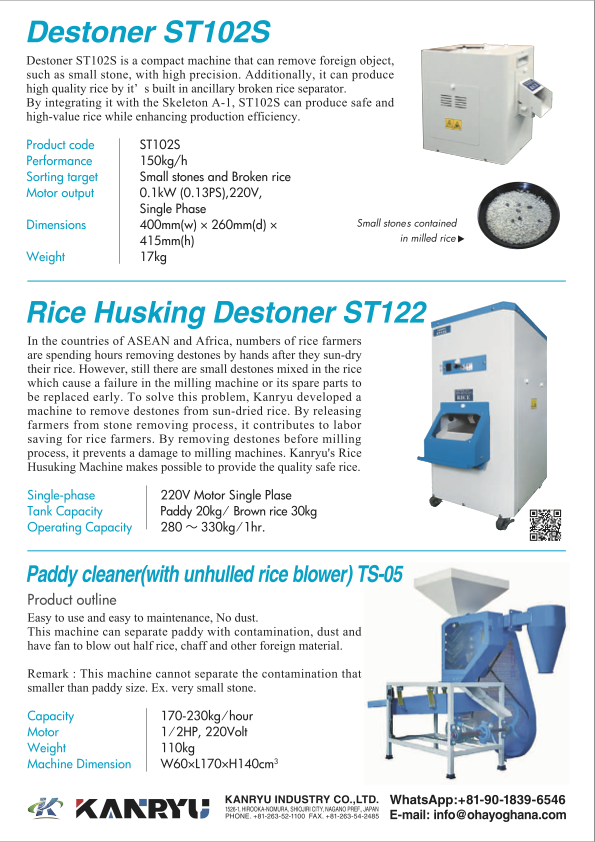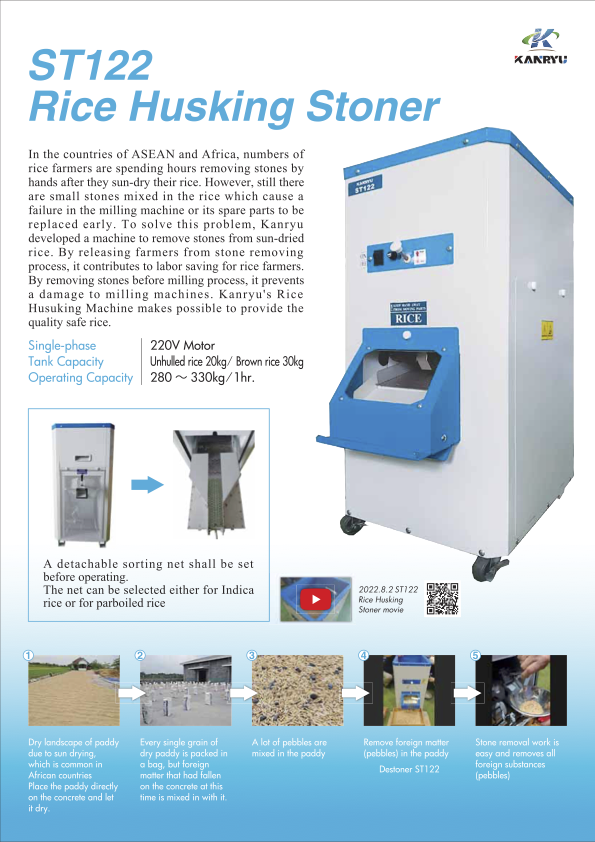Compact, Easy Operation & 
 Maintenance Rice Husking & Milling Unit with Destoner for Safe, Healthy, and Best Quality Rice
Maintenance Rice Husking & Milling Unit with Destoner for Safe, Healthy, and Best Quality Rice
R
Rice is often contaminated with foreign substances such as soil lumps, straws, dead insects, rat droppings, and pebbles in developing countries. This contamination not only jeopardizes rice quality but also poses a threat to machinery, escalating maintenance costs and diminishing operational efficiency for small-scale farmers. This technology is engineered to address these issues and foster new business and trade opportunities by completely removing foreign substances and producing high-quality polished rice.
This Rice Husking & Milling Unit comprises a set of machines designed to polish paddy into high-quality rice after threshing. The unit includes a pre-cleaner (TS-5), rice husking & milling machine (A-1), two types of destoners (ST102S or ST122), and a moisture meter (TA-5). Furthermore, a moisture meter helps obtain higher-quality polished rice by monitoring and adjusting the moisture content of the paddy to an optimal level.
By introducing this comprehensive set of machines, the quality of domestically produced rice will improve and empower small-scale farmers to increase their cash income.

Figure 1: Skelton A-1
Major Features and Advantages
The five products included in this unit boast durability, compact size, and simple construction, ensuring ease of operation for anyone. The synergy of these devices can contribute to increasing the added value of the rice value chain.
- Pre-cleaner: Removes large foreign objects such as soil lumps, rice straws, dead insects, mouse droppings, and stones from the paddy. This process minimizes damage to the de-stoning and rice milling machines, extending their operational lifespan.
- Rice polishing machine: Uses an impeller type to prevent breakage and ensure user-friendly operation. Trials conducted in Southeast Asia and Africa demonstrated an impressive rice crushing rate, reaching up to 40%. In contrast, the rubber roll type demands specialized knowledge for precise spacing adjustments, making set-up less straightforward. The rice polishing machine features easily replaceable parts and incorporates a straightforward broken rice remover, facilitating the sorting of damaged rice.
- De-stoner (2 types): The system efficiently eliminates smaller stones by conducting two rounds of stone removal from both paddy and milled rice. The oscillating specific gravity sorting method can even remove white stones and minute particles often overlooked by humans.
- Moisture meter: Proper moisture management is essential to maximize the capabilities of these machines and obtain higher-quality milled rice. In many developing countries, paddies are frequently either too dry or insufficiently dry. Accurate data obtained through a moisture meter enables farmers to monitor paddy conditions effectively, producing rice with enhanced added value.
Introducing the machines featuring these five devices will improve the quality of rice produced in small communities in developing countries. Moreover, in rice mills across these regions, the lack of parts replacement and maintenance for rubber roll rice milling machines often results in a deterioration of rice quality. This product addresses such issues by offering a reliable support system, ensuring sustained operational efficiency and improved rice quality.
 |
|
|
(From left) Skeleton A-1 Engine / Motor&ST102S, Destoner ST122, Paddy cleaner TS-05 |
Moisture Meter TA-5 |
Figure 2: Product Line-up for the International Market
Technology Data
Possible Applications
The population in developing countries, particularly in African nations, is continually growing, and with rice being a staple grain, local demand is significantly on the rise. On the other hand, these countries heavily depend on imports for essential resources like food, fertilizer, and fuel. Unfortunately, recent global events, such as the war in Ukraine, have led to soaring prices and increased challenges in procurement. This situation hinders the expansion of agricultural production in these regions.
In the context of rice cultivation in these countries, modern rice milling plants and large-scale rice milling equipment have been implemented in large-scale irrigated rice cultivation areas. These plants process paddy from hundreds to thousands of hectares of irrigated land. On the other hand, in rain-fed, low-marsh regions with favourable weather conditions and scattered small fields, such as valley rice fields, outdated Engelberg-type rice milling machines and one-pass milling machines are employed for rice milling operations without sufficient parts replacement.
The outdated machines and the absence of adequate support lead to a notable quantity of broken rice, resulting in substantial post-harvest losses. Furthermore, post-harvest, straw, other impurities, and stones smaller than rice grains are often mixed in due to hand-harvesting and sun-drying practices. Many rural communities also lack rice mills, compelling farmers to sell their rice to local traders before husking. This situation leaves them to negotiate prices and unaware of the quality of their rice.
The Skelton A-1 is a compact rice milling unit that uses an impeller mechanism instead of a traditional rubber roll for husking. Powered by a single-phase motor or engine, it can remove stones using the ST102S. Although its processing capacity is smaller than the one-pass type used by many other competitors’ rice mills, its compact size and adaptable power specifications make it easily integrated into rural communities. Introducing rice milling facilities to areas that previously lacked such infrastructure can produce milled rice instead of unhulled rice. In rural communities that initially did not or could not have rice mills, farmers can milled rice instead of unhulled rice, allowing farmers to negotiate prices depending on the degree of milling and quality. Moreover, the impeller mechanism minimizes broken rice and stone removal enhances milling quality, surpassing that of town rice mills. The ST122 further reduces stone damage, even during the unhulled rice stage, preserving the milling unit’s components.
Unlike the conventional rice milling machine sales, this technology targets rural communities, empowering farmers to enhance their income by providing control over rice sales price and distribution methods. This approach differs from the conventional model of selling milling machines to rice mills, offering significant potential to boost the income of rice farmers in developing countries.
Lastly, the product also solves the challenge of manual stone removal from rice, reducing the associated costs and health issues such as tooth damage for rice consumers. This promotes greater rice consumption and enriches consumer nutrition education.
Contribution to Sustainable Development Goals (SDGs)
Small-scale farmers in developing countries often rely on outdated Engelberg rice milling machines, leading to a significant portion of the milled rice ending up broken. Since the rice is typically sun-dried, it becomes susceptible to contamination with pebbles, significantly reducing the quality of the produced rice. Also, broken rice absorbs water, resulting in a sticky finished product. Pebbles also pose a concern for consumers, who must be cautious about encountering stones while eating the rice.
Kanryu Industry Co., Ltd. believes that introducing Skeleton A-1 and ST102S/ST122 will help address the challenges faced by outdated machines and improve food culture and education. This, in turn, will promote local production and consumption, enabling local children to eat safe and nutritious rice. This commitment aligns to support SDGs and address global food security challenges.
Kanryu Industry Co., Ltd. is registered as a Nagano Prefecture SDGs Promotion Company and actively supports Goal 2 of the SDGs, which aims to “End hunger, achieve food security and improved nutrition and promote sustainable agriculture”.
Competitive advantage
The technology has several comparative advantages, including ease of installation, simplicity of maintenance, and high quality of the milled rice as end product. In contrast, a competing product, the one-pass rice milling machine (SB type), uses two rubber rolls for husking and features a friction-based polishing section underneath. With the line-up of milling capacity of 500 kg/hr or higher, the one-pass type demands intricate adjustments between the two rubber rolls. Conversely, the Skelton A-1’s impeller design simplifies operation, requiring only straightforward replacement of the impeller and peripheral parts, enhancing user convenience and reducing maintenance complexity.
Additionally, the Skelton A-1 is powered by a single-phase motor, ensuring ease of operation even in areas without access to three-phase power supplies. It is compact and lightweight, making it easy to carry around. Unlike conventional rice mills, it can be installed simply by placing it on the floor without the need for anchoring to anchoring to a concrete floor. Therefore, the technology only requires minimal installation complexities and low associated costs. Furthermore, the impeller mechanism boasts a lower rice breakage rate compared to rubber rolls, particularly when operated in conjunction with a destoner, thereby enabling high-quality rice milling.
The capacity to produce high-quality milled rice within rural communities enhances the potential for adding value to rice prices at a farm-yard level. This creates an environment where farmers can assess quality directly, fostering awareness of technologies that improve paddy rice quality. This heightened awareness has subsequent development effects, including enhanced harvesting, threshing, drying, storage, and other related techniques.
Performance
The milling test results comparing the percentage of perfect rice grains produced by Skeleton A-1 and local rice in Ghana are shown below.
The percentage of perfect grains is the weight ratio of head rice (90% or more perfect grains) visually checked and selected from each 10g of rice.
- Kanryu Rice Milling Machine: The percentage of perfect grain was 75.73%
- Ghana Local Rice: The percentage of perfect grain was 59.47%
Technical maturity / Past record of introduction
|
Domestic production VSRH1562E/ST102S for Overseas Model |
International production Skelton A-1/ST102S |
|
| Rice Husking & Milling machine for Long-grain Sales Volume: | 300 units | 60 units |
| Destoner Sales Volume: | 200 units | 60 units |
| Years of Experience: | 9 years | 2 years (Due to the COVID-19 pandemic, there was a suspension period) |
Information on patent related to this technology
N/A
Company Data
Company data
| Name | Kanryu Industry Co., Ltd. |
| Address | 1526-1 Nomura Hirooka, Shiojiri-city, Nagano |
| Capital | 90 million JPY (as of 1 April 2023) |
| Contact person | Mr. Shuichi KONDOH YOA Africa Corp. (Export Agent) E-mail: sk@yoa-africa.co.jp TEL: +81-90-1839-6546 |
| Number of employees | 50 (as of 29 September 2023) |
| Date of company foundation | 18 April 1925 |
| Type of business | Development, manufacturing, and sales of agricultural machinery |
International operation
| Number of employees for international operation | 1 sales representative and 2 engineers |
| Overseas offices |
N/A |
Modality of business transaction
Export of product
Export and sales of products that are Knock Down by Thailand partner.
Attachments
Schematic illustration of the technology
Contact Person(s)
*Please mention that you saw UNIDO's website when making the first contact with the company.
Registered Category
- Agribusiness Technologies : Food value chain









